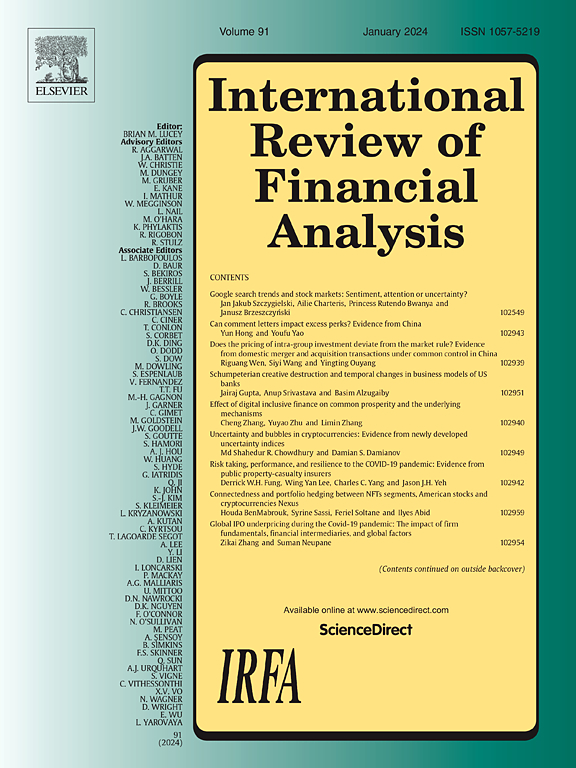ESG衍生品的可持续性套利定价
IF 7.5
1区 经济学
Q1 BUSINESS, FINANCE
引用次数: 0
摘要
本研究旨在通过引入由垂直于市场风险的环境、社会和治理成分引起的可持续性套利这一新概念,提出一种新的环境、社会和治理衍生品定价模型,并通过关注环境、社会和治理资产价格的均值回复特性,检验该模型在实践中的实用性。ESG 衍生品定价模型是不完全市场中良好交易约束(GDB)的扩展,可以克服 GDB 所需的外生夏普比率设置的随意性。使用 S&P、MSCI 和 STOXX 的 ESG 指数进行的实证研究表明,ESG 期货和看涨期权的可持续性套利定价的价格边界比原来的两倍夏普比率的良好交易边界要严格得多,两倍夏普比率是 Ross(1976)假设的任何投资组合绩效的最大值,Shanken(1992)称之为 "近似套利"。可持续性套利定价会产生与可持续性概念一致的相对严格的价格界限。然后,实证研究发现,ESG 指数的长期均值对可持续性套利定价中的 ES 风险溢价有很大影响。结果证实了环境、社会和治理指数的均值反转在环境、社会和治理衍生品定价中的重要性。可持续性套利定价产生了经济价值与 ESG 价值之间的正相关关系、买卖双方对 ES 风险的对称信息持有以及 ES 风险溢价的合理上限。ES 风险溢价的这三个特征可以证明可持续性套利定价在 ESG 衍生品定价的实践中是有效的。最后,我们通过计量经济学分析、使用最新扩展数据进行模型参数估计以及行权价对看涨期权价格的敏感性分析,讨论了所提模型和实证研究的有效性。本文章由计算机程序翻译,如有差异,请以英文原文为准。
Sustainability arbitrage pricing of ESG derivatives
This study aims to propose a new model of ESG derivative pricing by introducing a new concept of sustainability arbitrage arising from ES components vertical to market risk and examine the model’s usefulness in practice by focusing on the mean-reverting properties of ESG asset prices. The ESG derivative pricing model, an extension of good-deal bounds (GDB) in an incomplete market, can overcome the arbitrariness of setting the exogenous Sharpe ratio necessary for the GDBs. The empirical studies using ESG indices of S&P, MSCI, and STOXX demonstrate that the price boundaries from sustainability arbitrage pricing of ESG futures and call options are much tighter than those from the original good-deal bounds with twice the Sharpe ratio, which is the maximum of any portfolio performance as assumed in Ross (1976) and which Shanken (1992) calls “approximate arbitrage.” Sustainability arbitrage pricing generates relatively tight price boundaries consistent with sustainable concepts. Then, empirical studies find the long-term mean of ESG indices strongly affects ES risk premiums in sustainability arbitrage pricing. The results confirm the importance of mean-reversion of ESG indices in ESG derivative pricing. Sustainability arbitrage pricing produces a positive relationship between economic and ESG value, symmetric information holding of ES risk between buyers and sellers, and reasonable upper limits in ES risk premiums. These three features of the ES risk premium may prove that sustainability arbitrage pricing is valid for ESG derivative pricing in practice. Finally, we discuss the validities of the proposed models and empirical studies using an econometric analysis, model parameter estimation using more recent extended data, and a sensitivity analysis of strike prices to call option prices.
求助全文
通过发布文献求助,成功后即可免费获取论文全文。
去求助
来源期刊

International Review of Financial Analysis
BUSINESS, FINANCE-
CiteScore
10.30
自引率
9.80%
发文量
366
期刊介绍:
The International Review of Financial Analysis (IRFA) is an impartial refereed journal designed to serve as a platform for high-quality financial research. It welcomes a diverse range of financial research topics and maintains an unbiased selection process. While not limited to U.S.-centric subjects, IRFA, as its title suggests, is open to valuable research contributions from around the world.
 求助内容:
求助内容: 应助结果提醒方式:
应助结果提醒方式:


